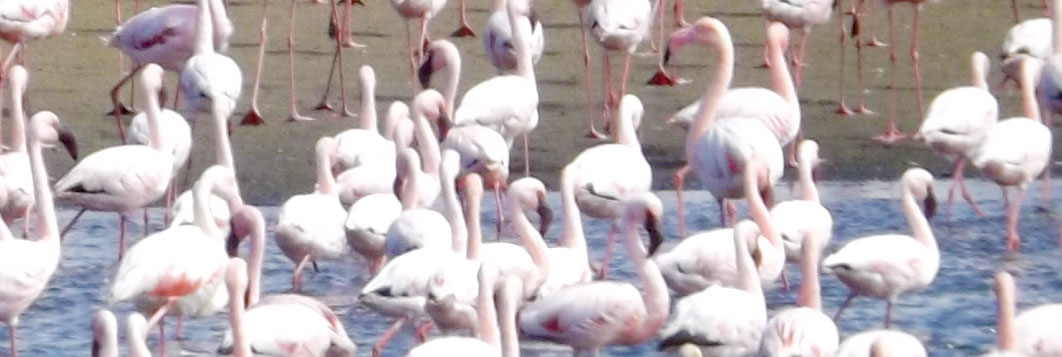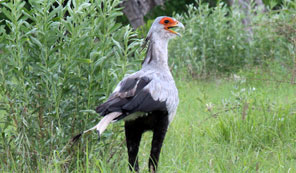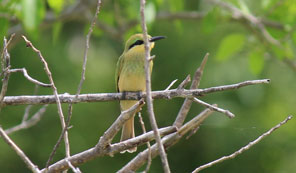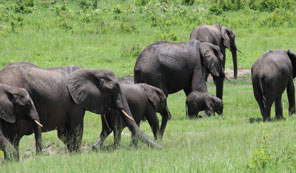
Namibian Safaris & Cultural Tours
Africa through the hearts of the people

|
Day 1 |
Windhoek – Kalahari Desert (±260km)
We depart early from Windhoek, travelling south towards the Kalahari Desert.
This beautiful semi-desert area of red sand and rolling dunes is also home to a wide variety of plants and animals. Dunes are dotted with patches of yellow grass, while shepherd trees and thorny acacias add shades of green. The Kalahari supports herds of oryx, springbok and ostrich, as well as cheetah, zebra, jackal, porcupine, badger, mongoose and many more. This area is home to the Kori Bustard, the largest flying bird of all, and huge colonies of weaver birds are resident on the lodge's grounds. [Kalahari Anib Lodge or similar | LD] |
|
Day 2 |
Kalahari Desert – Fish River Canyon (±280km)We have breakfast at the Lodge and then visit the striking Quiver tree forest. [Canon Roadhouse Lodge | BLD] |
|
Day 3 |
Fish River Canyon – Lüderitz (±350km)Today we head towards the Namib desert and coastal town of Lüderitz. [Nest Hotel or similar | BLD] |
|
Day 4 |
Lüderitz – Sesriem (±445km)After breakfast at the hotel, we depart for some bird-watching with the guide along the harbour. We visit Kolmanskop, the famous ghost town which lies abandoned in the sands of the Namib. It grew out of a diamond rush in the early 1900s, but was later abandoned when the diamond-field was exhausted. We continue towards Sesriem, passing by the wild horses. Lunch packs will be had en-route. [Namib Desert Lodge, Quiver Tree Camp or similar | BLD] |
|
Day 5 |
Sesriem – Sossusvlei – Sesriem (±120km)We wake up early to enjoy tea, coffee and biscuits and a magnificent sunrise over some of the world's highest dunes. [Namib Desert Lodge, Quiver Tree Camp or similar | BLD] |
|
Day 6 |
Sesriem – Swakopmund – Walvis Bay (±300km)Today we depart for Swakopmund, one of Namibia's charismatic coastal towns. We stop over at Solitaire, famous for its German cake apple crumble. We continue our journey, passing by the Gaub pass and Kuiseb river, where two Germans once hid, trying to escape the South Africans. We arrive in Swakopmund and settle into our accommodation. Swakopmund is a typical German town with its historic buildings built in the years 1884 to 1915. In the afternoon, you are free to try out some of the many activities Swakopmund has to offer (own account). These include:
We will do some bird-watching at the Walvis Bay Lagoon with the guide, updating our checklist of birds seen so far. Dinner will be at the Pelican Bay Hotel. [Pelican Bay Hotel or similar | BLD] |
|
Day 7 |
Walvis BayAfter breakfast, we will embark on a boat cruise which includes a wonderful brunch (no lunch). Get up close and personal with seals, dolphins and pelicans. Other possible sightings include whales, penguins, cormorants, petrels, gannets and oystercatchers. Enjoy a variety of seafood, soft drinks and sparkling wine. [Pelican Bay Hotel or similar | BLD] |
|
Day 8 |
Walvis Bay – Cape Cross – Brandberg (±260km)We travel north along the beautiful Namibian coastline to visit Cape Cross, home to one of the largest breeding colonies of Cape Fur Seals on the planet, with up to 210 000 seals present during November, December. Many species of coastal birds are often present here. [Brandberg White Lady Lodge | BLD] |
|
Day 9 |
Brandberg – Twyfelfontein (±160km)After breakfast, we leave forTwyfelfontein, where we enjoy lunch at the Twyfelfontein Country Lodge. Twyfelfontein is the site of one of the largest concentrations of rock petroglyphs (engravings) and rock paintings in Africa. It consists of a spring in a valley flanked by the slopes of a sandstone mountain. The rock art forms an extensive record of ritual practices relating to hunter-gatherer communities in this part of southern Africa over at least 2 millenia. UNESCO approved it as Namibia's first World Heritage Site in 2007. [Twyfelfontein Country Lodge or similar | BDL] |
|
Day 10 |
Twyfelfontein – Etosha National Park (±315km)Today we visit The Living Museum of the Damara, which lies close to Twyfelfontein and is the first traditional Damara project in Namibia and the only one of its kind. Here we have the unique opportunity to experience traditional Damara culture. Together with the Bushmen, the Damara belong to one of the oldest nations in Namibia. Their original nation was a mixture of hunter-gatherer culture and herders of cattle, goats and sheep. Although their culture is now largely lost, the museum contributes to its preservation, as well as bringing in an income for the Damara community that built it. The Etosha National Park spans an area of 22 270 square km, a large part of which is taken up by a vast salt pan. This beautiful barren and often haunting landscape is surprisingly abundant in game, which often congregate around the various waterholes scattered around the park, allowing for some spectacular game viewing. The park is home to hundreds of species of mammals, birds and reptiles, including several threatened and endangered species such as the black rhinocerous. Visitors can expect to see many buck species, elephants, giraffe, rhino and lions. If you are lucky you will see leopard and cheetah. After good rains, the salt pan fills with water attracting a mass of flamingos. More than 340 bird species have been counted in the park. [Okaukeujo or similar | BLD] |
|
Day 11 |
Etosha National Park (Okaukuejo - Namutoni) (±80km)Today will be a full day of safari game viewing allowing plenty of opportunities for good sightings and spectacular photographs of African birds and wildlife. [Halali Lodge or similar| BLD] |
|
Day 12 |
Etosha National Park (±80km)We have breakfast and depart early for a game drive in the eastern side of the park. Lunch will be enjoyed at one of the resorts inside the park. [Namutoni Lodge or similar | BLD] |
|
Day 13 |
Etosha National Park – Rundu (±426km)We have breakfast and depart early (the best time for seeing birds and animals) for another game drive in the eastern side of the park. We depart the park in the direction of Grootfontein where we will stop for lunch before continuing our journey to Rundu. [Omashare Lodge | BLD] |
|
Day 14 |
Rundu – Divundu (±200km)After breakfast at the lodge, we depart in the direction of Bagani. We will have lunch at the Popa Falls Lodge or similar. [Popa Falls Lodge or similar | BLD] |
|
Day 15 |
Divundu – Kongola (±180km)After breakfast, we embark on a game drive in the Mahangu National Park. This small game reserve is abundant in wildlife and offers great opportunities to see four of the big Five – Elephants, Buffalo, Lion and Leopard. More than 300 bird species are found here. The park is famous for its collection of wetland birds; including egrets, cranes, herons, pelicans, storks and various birds of prey like Pel's Fishing Owl and Montagu's Harrier. The park has even been designated as an “Important Bird Area” by BirdLife International. Look out for the very large Baobab Trees which are numerous in the park. [Mazambala Island Lodge or similar | BLD] |
|
Day 16 |
Kongola – Camp Chobe (±150km)Breakfast will be enjoyed at the lodge. We visit a nearby traditional village before departing towards the Caprivi region via Katima Mulilo. We arrive a Camp Chobe, near the Ngoma border post to Botswana, in time for lunch. [Camp Chobe | BLD] |
|
Day 17 |
Camp Chobe – Kasane (Botswana) – Victoria Falls (±145km)After breakfast, we cross into Botswana and continue to Kasane. We enjoy a game drive in the Chobe National Park and have lunch at the Chobe Safari Lodge. [Rainbow Hotel or similar | BLD] |
|
Day 18 |
Victoria FallsToday, we visit the spectacular Victoria Falls (Zimbabwe side), considered the largest in the world. The thundering waters can be heard from 40 km away while the spray and mist rise to a height of over 400 metres. [Rainbow Hotel or similar | BLD] |
|
Day 19 |
Victoria FallsAfter breakfast, you will be transferred to the Victoria Falls Airport for your connecting flight. [B] |
COST: N$ 69 500 per person
SPECIAL RATE for 2021: N$ 62 550 per person
MIN seats for this tour: 2
MAX seats for this tour: -
| Departure Date | Return Date | Seats Available |


